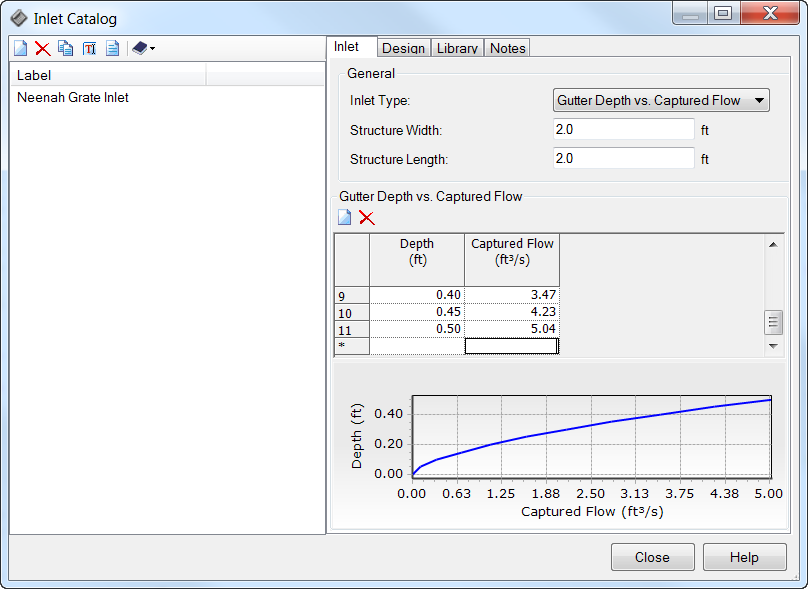| Applies To |
|
| Product(s): |
StormCAD, SewerGEMS, CivilStorm |
| Version(s): |
08.11.XX.XX, 10.XX.XX.XX |
| Area: |
Modeling |
Background
The Neenah Foundry Company (Neenah, Wisconsin - http://www.nfco.com) produces an extensive range of storm water inlets/catch basins, commonly referred to as 'Neenah grates'. These Neenah grates are not currently included in the default Engineering Libraries, but in OpenFlows products it is quite straightforward for users to add them as required.
Steps to accomplish
To Model a Neenah Grate for On Grade Inlets:
- For V8i version, go to Components > Inlet Catalog. For Connect Edition, go to Components > Catalog > Inlet Catalog
- In the Inlets Catalog dialog, click New. Type a name for the new inlet.
Note : We suggest using the Neenah catalog number and the transverse and longitudinal slopes that the curve capacity value will correspond to.
Unlike in HEC-22 calculations, there is no general relationship available for Neenah grate capacity versus longitudinal slope, so each Neenah grate is entered in OpenFlows products as Gutter Depth vs. Captured Flow’s curve which is specific to a particular transverse and longitudinal slope.
- Next click Inlet Type and select Gutter Depth vs. Captured Flow. Enter the below ground Structure Width and Structure Length.
- Now refer to the Neenah technical information to find the K value associated with this grate (for the appropriate transverse and longitudinal slopes).
- For this example, for a longitudinal slope of 2% and a transverse slope of 5%, use a K value of 16. Then a depth versus captured flow relationship can be determined using the equation: Q=K.D^(5/3). So:
|
Table 5-3: Depth vs. Flow Values
|
|
Depth (ft.)
|
Flow (cfs)
|
|
0.00
|
0.00
|
|
0.05
|
0.11
|
|
0.10
|
0.34
|
|
0.15
|
0.68
|
|
0.20
|
1.09
|
|
0.25
|
1.59
|
|
0.30
|
2.15
|
|
0.35
|
2.78
|
|
0.40
|
3.47
|
|
0.45
|
4.23
|
|
0.50
|
5.04
|
- Now this relationship can be copied and pasted into the Gutter Depth vs. Captured Flow area of the Inlet editor. To do this, copy the data to the windows clipboard, then in StormCAD, select the top right cell in Gutter Depth vs. Captured Flow grid and press Ctrl+V to paste.
Note : Make sure the units used in the inlet editor match the units used in determining the Depth vs. Captured Flow relationship.

The inlet is now set up and ready to use in the current OpenFlows project. To make it available for use in other projects, click on the Synchronization Options button and select Export to Library. To know how to add entries to Engineering Libraries, please see the below support solution.
http://communities.bentley.com/products/hydraulics___hydrology/w/hydraulics_and_hydrology__wiki/modifying-and-adding-entries-to-engineering-libraries
Note : For on-grade inlets, software solves for the corresponding upstream gutter depth & with the help of K value it looks for the corresponding captured flow on the gutter depth vs. captured flow curve. On-grade inlets depend specifically on the transverse & longitudinal slope. So users have to be careful that the curve they use is suitable for the inlet conditions, ultimately K value should be chosen appropriately.
To Model a Neenah Grate for In Sag Inlets:
For rectangular grates in sag, it is generally possible to enter a Neenah grate as a standard Grate Inlet Type.
However, please note that the OpenFlows products use the HEC-22 methodology for computing capacity, which does not always produce capacities that correspond to capacities given by Neenah Foundry (since some discharge coefficients are slightly different).
The designer should verify that they are satisfied with the calculated capacity in these cases.
For non-rectangular grates, the designer should compute, or request from Neenah Foundry, a Gutter Depth vs. Captured Flow relationship for the grate and then enter that in OpenFlows software using a procedure similar to the procedure outlined for Inlets On Grade above.
Note that the capacities of grate inlets in sag are not a function of the transverse of longitudinal slopes, so one Gutter Depth vs. Captured Flow curve per grate is sufficient for all transverse and longitudinal slopes.